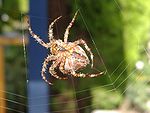- N-slit interferometer
-
The N-slit interferometer is an extension of the double-slit interferometer also known as Young's double-slit interferometer. One of the first known uses of N-slit arrays in optics was illustrated by Newton.[1] In the first part of last century, Michelson[2] described various cases of N-slit diffraction.Feynman[3] described thought experiments, of two-slit quantum interference, of electrons using Dirac's notation.[4] This approach was extended to N-slit interferometers using narrow-linewidth laser illumination, that is, illumination by indistinguishable photons, by researchers working on the measurement of complex interference patterns.[5] These interferograms are accurately reproduced, or predicted, by the N-slit interferometric equation for either even (N = 2, 4, 6,…), or odd (N = 3, 5, 7,…), numbers of slits.[6]
The N-slit laser interferometers, introduced by Duarte[6][7], use prismatic beam expansion to illuminate a transmission grating, or N-slit array, and a photoelectric detector array (such as a CCD or CMOS) at the interference plane to register the interferometric signal.[6][7][8] The expanded laser beam illumination in the N-slit interferometer can also take the shape, via the introduction of a convex lens prior to the prismatic expander, of a beam extremely elongated in the propagation plane and extremely thin in the orthogonal plane.[6][7] This use of one-dimensional (or line) illumination eliminates the need of point-by-point scanning in microscopy and microdensitometry.[6][7] Thus, these instruments can be used as straight forward N-slit interferometers or as interferometric microscopes.
These interferometers, originally introduced for applications in imaging,[6] are also useful in optical metrology and have been proposed for secure optical communications in free space.[9] Recent experimental developments include intra-interferometric path lengths of 35 meters[10] and 527 meters.[11]
 Interferogram for N = 3 slits with diffraction pattern superimposed on the right outer wing.[11]
Interferogram for N = 3 slits with diffraction pattern superimposed on the right outer wing.[11]
 The diffraction pattern over the interferogram shown above, corresponding to N = 3 slits, was generated using a single spider silk fiber with a diameter of about 25 μm.[11]
The diffraction pattern over the interferogram shown above, corresponding to N = 3 slits, was generated using a single spider silk fiber with a diameter of about 25 μm.[11]
These large, and very large, N-slit interferometers[10][11] are also being used to study the effect of intra interferometric clear air turbulence[10] and the effect of microscopic disturbances[11] on propagating interferometric signals. This work has yielded the first observation of diffraction patterns superimposed over propagating interferograms.[11]
These diffraction patterns (as shown in the first photograph) are generated by inserting a spider web fiber (or spider silk thread) on to the propagation path of the N-slit interferogram. The position of the spider web fiber is perpendicular to the plane of propagation.[11]
N-slit interferometers are also of interest to researchers working in atom optics,[12] Fourier imaging,[13] and quantum computing.[14]
Note: N-slit interferometers include three-slit interferometers (or triple-slit interferometers), four-slit interferometers, etc.[9][10][11]
See also
References
- ^ I. Newton, Opticks (Royal Society, London, 1704).
- ^ A. A. Michelson, Studies in Optics (Chicago University, Chicago, 1927).
- ^ R. P. Feynman, R. B. Leighton, and M. Sands, The Feynman Lectures on Physics, Vol. III (Addison Wesley, Reading, 1965).
- ^ P. A. M. Dirac, The Principles of Quantum Mechanics, 4th Ed. (Oxford, London, 1978).
- ^ F. J. Duarte and D. J. Paine, Quantum mechanical description of N-slit interference phenomena, in Proceedings of the International Conference on Lasers '88, R. C. Sze and F. J. Duarte (Eds.) (STS, McLean, Va, 1989) pp. 42–47.
- ^ a b c d e f F. J. Duarte, On a generalized interference equation and interferometric measurements, Opt. Commun. 103, 8-14 (1993).
- ^ a b c d F. J. Duarte, Electro-optical interferometric microdensitometer system, US Patent 5255069 (1993).
- ^ F. J. Duarte, in High Power Dye Lasers (Springer-Verlag, Berlin, 1991) Chapter 2.
- ^ a b F. J. Duarte, Secure interferometric communications in free space: enhanced sensitivity for propagation in the metre range, J. Opt. A: Pure Appl. Opt. 7, 73–75 (2005).
- ^ a b c d F. J. Duarte, T. S. Taylor, A. B. Clark, and W. E. Davenport, The N-slit interferometer: an extended configuration, J. Opt. 12, 015705 (2010).
- ^ a b c d e f g h F. J. Duarte, T. S. Taylor, A. M. Black, W. E. Davenport, and P. G. Varmette, N-slit interferometer for secure free-space optical communications: 527 m intra interferometric path length , J. Opt. 13, 035710 (2011).
- ^ L-B. Deng, Theory of atom optics: Feynman path integral approach, Frontiers Phys. China 1, 47-53 (2006).
- ^ H. Liu et al., Fourier-transform ghost imaging with pure far field correlated thermal light,Phys. Rev. A. 76, 053808 (2007).
- ^ J. F. Clauser and J. P. Dowling, Factoring integers with Young’s N-slit interferometer, Phys. Rev. A 53, 4587–4590 (1996).
External links
Categories:- Optics
- Interference
- Interferometry
- Interferometers
- American inventions
Wikimedia Foundation. 2010.
